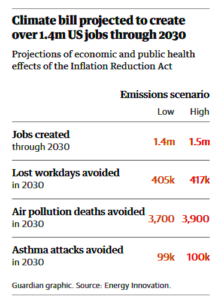U.S. Senate Passes Historic Climate Bill, Hawaii Benefits – part 1
Originally published August 7th ––
With direct economic, social, and environmental benefits for Hawaii, the legislation, known as the Inflation Reduction Act, will slash America’s planet-heating emissions by about 40% by the end of the decade, compared with 2005 levels.
Hawaii’s residents and businesses will benefit first hand from the bill’s economic assistance within a number of practical areas, as it serves as a major economic enabler for the state in transitioning to a clean energy economy and achieving Hawaii’s statewide goal of a fossil fuel-free electric grid by no later than 2045.
The bill’s emissions cut enablers will further bring the US within striking distance of a goal set by President Biden to cut emissions in half by 2030, a target that scientists say must be achieved if effects of catastrophic global heating, triggering escalating heatwaves, droughts and floods, now on the increase are mitigated.
Senator Brian Schatz (HI), described the bill’s passage as … “by far, the biggest climate action in human history”.
Billions of Federal investment dollars will go towards investments into clean and zero emissions renewable energy; such as wind, solar, battery storage, and hydrogen. The bill’s passage also includes electric vehicle purchase rebates for low-to-moderate income working families and businesses seeking to buy electric cars and trucks, support for households to run on clean electricity, while adopting energy efficiency strategies and products.

Democratic Senate Leader Chuck Schumer, on Passage of the Major Climate and Health Care reform bill – video link: https://youtu.be/LQmDwgvf49s
The Inflation Reduction Act in Summary
- The primary benefits of the bill will be a major reduction in U.S. greenhouse gas emissions by between 31% and 44% below 2005 levels by 2030, according to Rhodium Group, a non-partisan research firm. A separate analysis by Energy Innovation, another research house, has found a similar reduction, of between 37% and 41% this decade. In total, around 1bn tons of greenhouse gases, which is more than double the total annual emissions of the UK, would be eliminated within the next 10 years.
The range of estimates depends on factors such as future economic conditions, but experts say the bill will set off a cascade of positive impacts;
- pushing fossil fuels out of the energy grid,
- dampening America’s thirst for oil and
- further enable the wind and solar energy transformation of the electric grid by replacing the present day fossil fuel dependencies,
- A new system of fees will be imposed to stem leaks of methane, a potent greenhouse gas, from oil and gas drilling operations.
- Consumer – Homeowner – Business Benefits (see below)
- The vast fleet of trucks used by the US Postal Service today will go all-electric.
“This bill will really turbocharge that transition to clean energy, it will transform markets where already solar PV, wind and batteries are in many cases cheaper than incumbent fossil fuels,” said Anand Gopal, executive director of policy at Energy Innovation.
“This is a dramatically large climate bill, the biggest in US history, when is passes in the House later this week, and is signed into law by President Biden. It doesn’t, however, mean the US won’t need to do more to achieve its emissions goals, but it will make a meaningful difference.”
The bulk of the bill is composed of tax credits aimed at unleashing a boom in clean energy deployment, along with payments to keep ageing nuclear facilities and other sources of low-carbon energy online.
The US is, following decades of political rancor and fossil fuel industry obfuscation, almost certain to make its first significant attempt to tackle the climate crisis. Experts say it will help rewire the American economy and act as an important step in averting disastrous global heating.
Independent analysis of the proposed legislation, known as the Inflation Reduction Act, shows it should slash America’s planet-heating emissions by about 40% by the end of the decade, compared with 2005 levels. This cut would bring the US within striking distance of a goal set by President Biden to cut emissions in half by 2030, a target that scientists say must be achieved by the whole world if catastrophic global heating, triggering escalating heatwaves, droughts and floods, is to be avoided.
Consumer – Homeowner – Business Benefits
Blistering heatwaves, extreme storms, droughts, flooding, meltdowns in polar icecaps are just the beginning effects of global heating. Soon consumers will be able to do their part in the solution, while accessing Federal rebates of up to $7,500 for a new electric vehicle, or up to $4,000 for a used car, along with up to $8,000 to install a modern electric heat pump that can both heat and cool buildings. Further rebates are also on offer, such as $1,600 to insulate and seal a house to make it more energy efficient.
The Greenhouse Gas Reduction Fund provides $27 billion in funding, of which $15 billion will enable low-income and disadvantaged communities to benefit from zero emission technologies and other greenhouse gas pollution reductions.
The Clean Vehicle credit, or 30D, gives a $7,500 credit for new electric vehicles and a $4,000 credit for used electric vehicles. This will help everyday Americans afford to get an EV and start saving money every month. Operating an EV costs $1/gallon, which is way more affordable than an internal combustion engine car. This incentive will make clean cars the default and affordable choice for everyday Americans.
The High Efficiency Electric Home Rebate Act (HEEHRA), included within the bill, provides $4.5 billion in direct rebates for low-and moderate-income households that install new, efficient electric appliances, using a framework proposed in our Appliance Rebate Plan. For instance, a low income household will receive a rebate covering the full cost of a heat pump installation for space heating, up to a cap of $8,000.
These actions would cut emissions while having other significant benefits. In the national transition to a clean energy economy, the bill will add as many as 1.5m jobs created within the growing clean energy sector, according to Energy Innovations.
Rewiring America forecasts that U.S. households that install, rooftop solar and drive an electric car will save $1,800 a year on energy costs, and for Hawaii state residents with the nation’s highest electric bills, that figure could be as high as $3,000 in annual savings and households budgets.
The Energy Efficient Home Improvement credit, or 25C, allows households to deduct from their taxes up to 30 percent of the cost of upgrades to their homes, including installing heat pumps, insulation and, importantly, upgrading their breaker boxes to accommodate additional electric load. Upgrade costs include both equipment and installation/labor costs. These deductions are limited to $600 per measure, up to $1,200 per household per year—with one notable exception. Households can deduct 30 percent of the costs for buying and installing a heat pump water heater or heat pump for their space heating and cooling, up to $2,000.
The Residential Clean Energy credit, or 25D, re-ups an existing program allowing households installing solar to deduct 30 percent of the cost of the project from their taxes. This credit is guaranteed for 10 years, and now also includes residential battery storage systems.
The New Energy Efficient Home credit, or 45L, has received a substantial boost, providing up to $5,000 to developers to build homes that qualify for the Department of Energy’s Zero Energy Ready Homes standard. This applies to new single family, multifamily and manufactured homes, as well as existing homes that undergo a deep retrofit.
The Residential Clean Energy credit, or 25D, re-ups an existing program allowing households installing solar to deduct 30 percent of the cost of the project from their taxes. This credit is guaranteed for 10 years, and now also includes residential battery storage systems.
The Commercial Buildings Energy Efficient credit, or 179D, has been significantly expanded, offering $2.50 to $5.00 per square foot for businesses achieving 25 to 50 percent reductions in energy use over existing building performance standards.
The Rebirth of U.S. Manufacturing
 The legislation also addresses the nation’s strategic current supply dependencies with China, which (in the last ten years) has become the world’s leading manufacturer of solar panels, batteries and other clean energy materials.
The legislation also addresses the nation’s strategic current supply dependencies with China, which (in the last ten years) has become the world’s leading manufacturer of solar panels, batteries and other clean energy materials.
- There are billions of dollars in incentives for the US domestic production of wind turbines, solar panels, batteries, carbon capture and storage and other clean energy technologies. Most specifically, $30 billion is available as a production tax credit to accelerate U.S. manufacturing of solar panels, wind turbines, batteries and critical minerals processing in the U.S., and another $10 billion is allocated as an investment tax credit for building new facilities that manufacture these technologies.
Reinventing American Energy Dependency & Global Climate Creditability
The bill should change the way the US is viewed on the global stage and will encourage better pledges from other large emitters such as China and India, when fully implemented, experts estimate bill’s outcome benefits will be to keep temperature rise under 2C (3.6F).
Unfortunately, the world has passed the point of its previous 1.5C cap on greenhouse gas impacts, which scientists now see as a stretch to reach this previous goal.
Some Climate advocates have criticized elements of the bill, specially Senator Joe Manchin’s successful insistence that oil and gas drilling leases in Alaska and the Gulf of Mexico be included, along with a stipulation that millions of acres of federal land and water are opened up for fossil fuels if they are to be also accessed by solar and wind developers.
Energy sector researchers believe the clean energy benefits of the bill easily outweigh any extra emissions from new drilling, with every ton of new emissions offset by at least 24 tons of emissions avoided by other provisions. Yet the economics, social, environmental and climate benefits from today’s lower cost solar, wind, and storage energy increasingly recognized by electric utilities, primary energy customers of fossil fuels outside of transportation, increasingly are choosing solar and wind options ahead of fossil fuels options, if for no other reason than cost, and the gap continues to grow in favor of clean and climate-friendly energy options.
Finally, the bill’s passage in the Senate represents the U.S. joining other large economies, in producing a long-term climate roadmap to sustainable and clean energy-driven economy.
“The Earth Can, and Will be Saved … If we work for a Sustainable Future, We will Achieve It.”
Elon Musk, Tesla (TSLA) shareholders meeting, August 4, 2022




Leave a Reply
Join the Community discussion now - your email address will not be published, remains secure and confidential. Mahalo.